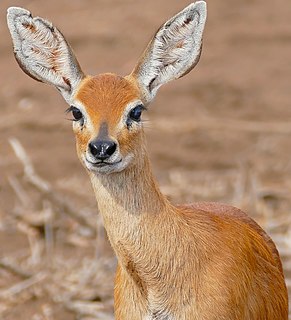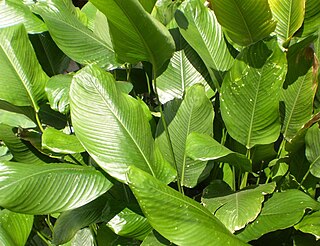
The Capparaceae, commonly known as the caper family, are a family of plants in the order Brassicales. As currently circumscribed, the family contains 33 genera and about 700 species. The largest genera are Capparis, Maerua, Boscia and Cadaba.

Raphicerus is a genus of small antelopes of the tribe Neotragini.

Firmiana is a genus of flowering plant in the family Malvaceae, formerly placed in the now defunct Sterculiaceae; it may sometimes be called the "parasol tree". The genus name honours Karl Joseph von Firmian.

Sandoricum is an Asian genus of plants in the family Meliaceae. It contains the economically significant santol fruit tree.
Siphonodon is a small genus of flowering plants in the family Celastraceae.
Swintonia is a genus of plants in the family Anacardiaceae.

Colona evecta is a tree species, first described by Pierre, in the genus Colona and now placed in the subfamily Grewioideae. No subspecies are listed in the Catalogue of Life.

Colona auriculata is a shrub species first described by Desfontaines, with its current name after Craib; the genus Colona is in the family Malvaceae and now placed in the subfamily Grewioideae. No subspecies are listed in the Catalogue of Life.
Ryania is a genus of plants in the family Salicaceae; it was previously listed in the now defunct family Flacourtiaceae.
Sterculia hypochroa is a tree species described by Pierre, belonging to the genus Sterculia and the family Malvaceae. No subspecies are listed in the Catalogue of Life. These trees are found in Vietnam, where they are known as trôm quạt.

Austracris is a genus of Orthoptera: Caeliferan insect in the family Acrididae: subfamily Cyrtacanthacridinae. It includes an Australian pest, the spur-throated locust.

Greenwayodendron is a small genus of flowering plants in the family Annonaceae.

Sterculia lanceolata is a tree species, belonging to the genus Sterculia and the family Malvaceae. The species can be found in southern China and Vietnam.
Sterculia rubiginosa is a plant species, belonging to the genus Sterculia and the family Malvaceae. The species can be found in the Andaman and Nicobar islands, Myanmar (Burma), southern Thailand, Malesia, the Philippines and Vietnam.
Sterculia stigmarota is a plant, belonging to the genus Sterculia and the family Malvaceae. This species is found only in southern Vietnam and there are no subspecies listed in the Catalogue of Life.

Cystacanthus is a genus of plant in the family Acanthaceae, found in south-east Asia.

Stachyphrynium placentarium is a species of plant in the family Marantaceae. Its basionym was Phyllodes placentaria Lour. and was subsequently long placed as various species in the genus Phrynium. The species is widespread throughout Asia, with records from Bhutan, southern China, India, Indo-China and Indonesia; no subspecies are listed in the Catalogue of Life.
Costantinella is a genus of anamorphic fungi in the family Morchellaceae and class Pezizomycetes
Parishia is an Asian plant genus in the family Anacardiaceae, subfamily Anacardioideae. It is found in Indo-China and Malesia; no subspecies are listed in the Catalogue of Life.
Nemotha is an Asian genus of praying mantids in the family Hymenopodidae: tribe Anaxarchini, contatining a single described species, Nemotha metallica. The genus was previously placed in the Iridopterygidae, and two species have been placed in the revived genus Tricondylomimus.











